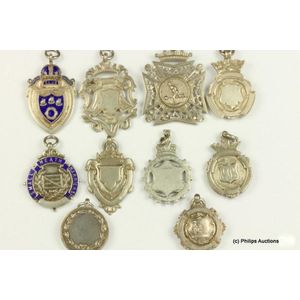Set of 4 Antique Floral Sterling Silver Open Salts
Edward, Edward Junior, John and William Barnard, London 1829 set of sterling silver open salts embossed floral decoration, cast leaf rim, gilded interior each on four feet (4). Weight 515 grams
You must be a subscriber, and be logged in to view price and dealer details.
Subscribe Now to view actual auction price for this item
When you subscribe, you have the option of setting the currency in which to display prices to $Au, $US, $NZ or Stg.
This item has been sold, and the description, image and price are for reference purposes only.
- Sterling Silver - Sterling silver is a mixture of 92.5% pure silver and 7.5% of another metal, usually copper. Fine silver is 99.9% pure silver, and is relatively soft and the addition of the very small amount of copper gives the metal enough strength and hardness to be worked into jewellery, decorative and household objects.
- Embossed / Repousse - Embossing, also known as repousse, is the technique of decorating metal with raised designs, by pressing or beating out the design from the reverse side of the object.It is the opposite of chasing, where the decoration is applied from the front. An embossed or repoussed object may have chasing applied to finish off the design.
- Gilding - Gilding is a method of ornamentation whereby a thin sheet of gold metal is applied to items made of wood, leather, ceramics, glass and silver for decorative purposes.
For furniture including mirrors, the sheet of gold is usually applied over a coating of gesso. Gesso is a mixture of plaster of Paris and gypsum mixed with water and then applied to the carved wooden frames of mirrors and picture frames as a base for applying the gold leaf. After numerous coats of gesso have been applied, allowed to dry and then sanded a coat of "bole", a usually red coloured mixture of clay and glue is brushed on and allowed to dry, after which the gold leaf is applied. Over time parts of the gilding will rub off so the base colour can be seen. In water gilding, this was generally a blue colour, while in oil gilding, the under layer was often yellow. In Victorian times, gilders frequently used red as a pigment beneath the gold leaf.
Metal was often gilded by a process known as fire gilding. Gold mixed with mercury was applied and heated, causing the mercury to evaporate, the long-term effect of which was to kill or disable the craftsman or woman from mercury poisoning. The pursuit of beauty has claimed many victims, not the least of which were the artists who made those pieces so highly sought after today.
Visually similar items

Ten silver fob medallions. All sterling silver antique medallion fobs, five of round shape, four of shield shape and one oval, all detailed with inscriptions & Hallmarks, four further detailed by enamel work
Sold by
in
for
You can display prices in $Au, $US, $NZ or Stg.

Set of 6 Austrian silver coffee cups & saucers, 800 silver. Approx 1kg weight
Sold by
in
for
You can display prices in $Au, $US, $NZ or Stg.

A pair of 19th century champleve enamel candlesticks. Height 16 cm
Sold by
in
for
You can display prices in $Au, $US, $NZ or Stg.

18ct yellow gold, natural ruby & diamond ring, with oval rubies surrounded by diamonds stamped 750
Sold by
in
for
You can display prices in $Au, $US, $NZ or Stg.
